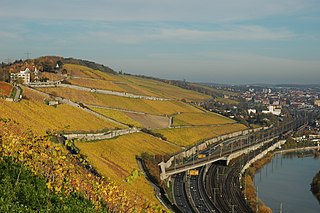
Merlot is a dark blue–colored wine grape variety, that is used as both a blending grape and for varietal wines. The name Merlot is thought to be a diminutive of merle, the French name for the blackbird, probably a reference to the color of the grape. Its softness and "fleshiness," combined with its earlier ripening, make Merlot a popular grape for blending with the sterner, later-ripening Cabernet Sauvignon, which tends to be higher in tannin.

Cabernet Sauvignon is one of the world's most widely recognized red wine grape varieties. It is grown in nearly every major wine producing country among a diverse spectrum of climates from Australia and British Columbia, Canada to Lebanon's Beqaa Valley. Cabernet Sauvignon became internationally recognized through its prominence in Bordeaux wines, where it is often blended with Merlot and Cabernet Franc. From France and Spain, the grape spread across Europe and to the New World where it found new homes in places like California's Santa Cruz Mountains, Paso Robles, Napa Valley, New Zealand's Hawke's Bay, South Africa's Stellenbosch region, Australia's Margaret River, McLaren Vale and Coonawarra regions, and Chile's Maipo Valley and Colchagua. For most of the 20th century, it was the world's most widely planted premium red wine grape until it was surpassed by Merlot in the 1990s. However, by 2015, Cabernet Sauvignon had once again become the most widely planted wine grape, with a total of 341,000 hectares (3,410 km2) under vine worldwide.

Syrah, also known as Shiraz, is a dark-skinned grape variety grown throughout the world and used primarily to produce red wine. In 1999, Syrah was found to be the offspring of two obscure grapes from southeastern France, Dureza and Mondeuse Blanche. Syrah should not be confused with Petite Sirah, a cross of Syrah with Peloursin dating from 1880.

Cabernet Franc is one of the major black grape varieties worldwide. It is principally grown for blending with Cabernet Sauvignon and Merlot in the Bordeaux style, but can also be vinified alone, as in the Loire's Chinon. In addition to being used in blends and produced as a varietal in Canada and the United States, it is sometimes made into ice wine in those regions.

Zinfandel is a variety of black-skinned wine grape. The variety is grown in over 10 percent of California vineyards. DNA analysis has revealed that it is genetically equivalent to the Croatian grapes Crljenak Kaštelanski and Tribidrag, as well as to the Primitivo variety traditionally grown in Apulia, where it was introduced in the 18th century and Kratošija in Montenegro. The grape found its way to the United States in the mid-19th century, where it became known by variations of a name applied to a different grape, likely "Zierfandler" from Austria.

Mourvèdre is a red wine grape variety grown in many regions around the world including the Rhône and Provence regions of France, the Valencia and Jumilla and Yecla denominaciones de origen (DOs) of Spain, as well as the Balearic Islands, California and Washington and the Australian regions of South Australia and New South Wales, as well as South Africa. In addition to making red varietal wines, Mourvèdre is a prominent component in "GSM" blends. The variety is also used to make rosé and port-style fortified wines.

McLaren Vale is a wine region in the Australian state of South Australia located in the Adelaide metropolitan area and centred on the town of McLaren Vale about 38 kilometres (24 mi) south of the Adelaide city centre. It is internationally renowned for the wines it produces and is included within the Great Wine Capitals of the World. The region was named after either David McLaren, the Colonial Manager of the South Australia Company or John McLaren (unrelated) who surveyed the area in 1839. Among the first settlers to the region in late 1839, were two English farmers from Devon, William Colton and Charles Thomas Hewett. William Colton established the Daringa Farm and Charles Thomas Hewett established Oxenberry Farm. Both men would be prominent in the early days of McLaren Vale. Although initially the region's main economic activity was the growing of cereal crops, John Reynell and Thomas Hardy planted grape vines in 1838 and the present-day Seaview and Hardy wineries were in operation as early as 1850. Grapes were first planted in the region in 1838 and some vines more than 100 years old are still producing. Today there are more than 88 cellar doors in McLaren Vale. The majority are small family-run operations and boutique wineries.

Penfolds is an Australian wine producer that was founded in Adelaide in 1844 by Christopher Rawson Penfold, an English physician who emigrated to Australia, and his wife Mary Penfold. It is one of Australia's oldest wineries, and is currently part of Treasury Wine Estates.

Max Schubert was a pioneering Australian winemaker, with Penfolds, who is best known as the creator of Grange Hermitage. Schubert was included in the Sydney Morning Herald's 100 most influential Australians of the century, which was published in 2001.

Turkey Flat is an Australian winery located in Tanunda, in the middle of South Australia's Barossa Valley wine-growing region. It is described by wine expert Oz Clarke as one of the "cult wines" of Australia. With more than 40% of its production dedicated to rosés, Turkey Flat has been considered a leader in the recent "rosé revival" trend of the early 21st century.

Paul Draper is a California winemaker who has been the chief winemaker at Ridge Vineyards in California since 1969. Without any formal training in winemaking, Draper first gained recognition for his 1971 Monte Bello Cabernet Sauvignon when it placed fifth at the Judgment of Paris wine tasting. Draper has played a significant role in the history of California wine through his pioneering work in popularizing "vineyard-designated" wines as well as instigating the resurgence of old vine Zinfandel. Along with Ravenswood Winery's Joel Peterson, Draper is considered one of the most important figures in the history of Californian Zinfandel, rescuing the grape from obscurity and demonstrating its full potential as a serious wine. Draper was featured in a short film titled Terroir and directed by Christopher McGilvray which was shown at the 2017 Cinequest Film Festival.

The South Australian wine industry is responsible for more than half the production of all Australian wine. South Australia has a vast diversity in geography and climate which allows the state to be able to produce a range of grape varieties–from the cool climate Riesling variety in the Clare Valley wine region to the big, full bodied Shiraz wines of the Barossa Valley.
This glossary of viticultural terms list some of terms and definitions involved in growing grapes for use in winemaking.

Elderton Wines is an Australian winery in Nuriootpa, in the Barossa Valley. The company was founded by Neil and Lorraine Ashmead in 1979. The Elderton wines are made from grape varieties including red grapes Shiraz, Cabernet Sauvignon, Merlot and Zinfandel as well as white grapes Riesling and Chardonnay.

The Barossa Valley wine region is one of Australia's oldest and most premier wine regions. Located in South Australia, the Barossa Valley is about 56 km northeast of the city of Adelaide. Unlike most of Australia whose wine industry was heavily influenced by the British, the wine industry of the Barossa Valley was founded by German settlers fleeing persecution from the Prussian province of Silesia. The warm continental climate of the region promoted the production of very ripe grapes that was the linchpin of the early Australian fortified wine industry. As the modern Australian wine industry shifted towards red table wines in the mid-20th century, the Barossa Valley fell out of favor due to its reputation for being largely a Syrah from producers whose grapes were destined for blending. During this period the name "Barossa Valley" rarely appeared on wine labels. In the 1980s, the emergence of several boutique families specializing in old vine Shiraz wines began to capture international attention for the distinctive style of Barossa Shiraz, a full bodied red wine with rich chocolate and spice notes. This led to a renaissance in the Barossa Valley which catapulted the region to the forefront of the Australian wine industry.

Wine Grapes - A complete guide to 1,368 vine varieties, including their origins and flavours is a reference book about varieties of wine grapes. The book covers all grape varieties that were known to produce commercial quantities of wine at the time of writing, which meant 1,368 of the known 10,000 varieties. It is written by British Masters of Wine Jancis Robinson and Julia Harding in collaboration with Swiss grape geneticist Dr. José Vouillamoz.

Žametovka is a red Slovenian wine grape variety. This is one of the oldest domesticated grape varieties in Slovenian. Formerly it was popular in Styrian vineyards, and even more so, even today, known in Dolenjska in southeast Slovenia - from the reddish wine cviček. It produces a wine of pure red color. A single vine of Žametovka growing in the Slovenian town of Maribor is estimated by the Guinness Book of Records to be the oldest living vine still producing fruit in the world at over 400 years of age.

Würzburger Stein is a vineyard in the German wine region of Franconia that has been producing a style of wine, known as Steinwein since at least the 8th century. Located on a hill overlooking the Main river outside the city of Würzburg, the vineyard is responsible for what may have been the oldest wine ever tasted. In addition to being one of Germany's oldest winemaking sites, at 85 hectares, the vineyard is also one of Germany's largest individual plots.
Cabernet blanc is a white German and Swiss wine grape variety that is a crossing of the French wine grape Cabernet Sauvignon and Regent. The grape was bred by Swiss grape breeder Valentin Blattner in 1991. Cabernet blanc has strong resistance to most grape disease including botrytis bunch rot, downy and powdery mildew and tends to produce loose clusters of small, thick-skinned grape berries which can hang on the vine late into the harvest season to produce dessert wines. Today the grape is found primarily in the Palatinate wine region of Germany with some experimental plantings in Spain and the Netherlands. In France, in the Languedoc, Domaine La Colombette is heavily investing in PIWI grapes. Amongst others the Cabernet Blanc in their cuvée "Au Creux du Nid", is gaining wide acclaim.

Versoaln is a white Italian wine grape variety that is grown in the South Tyrol wine region of northeast Italy. In the commune of Tisens, in South Tyrol, one of the world's oldest vines is a Versoaln vine planted at Katzenzungen Castle that has been dated to be at least 350 years old by the viticulturists at the University of Göttingen.




















